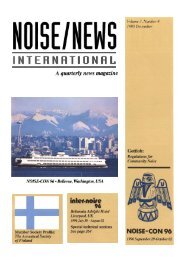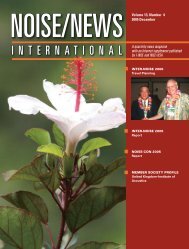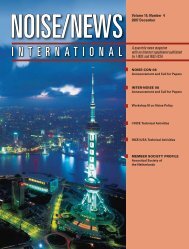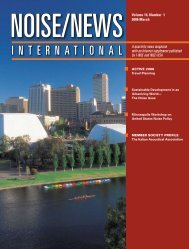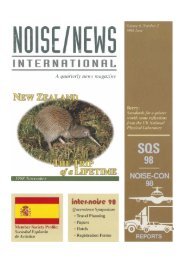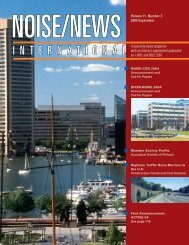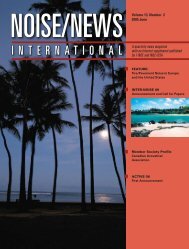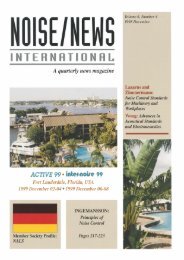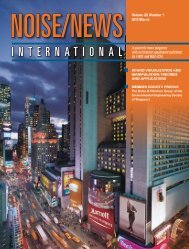Volume 14, Number 4, December, 2006 - Noise News International
Volume 14, Number 4, December, 2006 - Noise News International
Volume 14, Number 4, December, 2006 - Noise News International
Create successful ePaper yourself
Turn your PDF publications into a flip-book with our unique Google optimized e-Paper software.
Outdoor equipment:<br />
Current situation on noise<br />
emissions and strategies<br />
for control<br />
Eleonora Carletti - IMAMOTER-<br />
National Research Council of Italy<br />
[Summary received; panelist unable<br />
to present.]<br />
The new EU noise policy for a “quieter”<br />
Europe is significantly affecting research in<br />
noise control. Attention has been focused on<br />
the reduction of noise emitted by outdoor/<br />
indoor industrial equipment and mobile<br />
machinery. Although outdoor equipment<br />
covers a wide range of mechanical devices,<br />
most are operated by an internal combustion<br />
engine and, consequently, have the same<br />
dominant noise sources (diesel engine,<br />
exhaust, and cooling system). For these<br />
machines and equipment, several noise<br />
and vibration research programs have been<br />
completed. New concepts in the design of<br />
these components have been introduced as<br />
have innovative noise and vibration control<br />
technologies.<br />
The target defined by EU noise policy for<br />
outdoor equipment is to reduce by 50% the<br />
noise annoyance caused by these sources.<br />
To achieve this goal and be in line with<br />
the expectations of the Environmental<br />
<strong>Noise</strong> Directive (2002/49/EC), a specific<br />
Directive relating to noise emission in the<br />
environment by outdoor equipment has<br />
been in force since 2001 (2000/<strong>14</strong>/EC).<br />
This Directive defines measurement<br />
methods and permissible sound power<br />
levels. It applies to 57 types of outdoor<br />
equipment—35 of these require noise<br />
labels and 22 require compliance with<br />
permissible sound power levels. The<br />
Directive established noise limits in two<br />
stages: Stage I starting in 2002 January<br />
and Stage II, with reduced levels, starting<br />
in <strong>2006</strong> January.<br />
Prior to <strong>2006</strong>, studies on possible noise<br />
reduction for some types of equipment<br />
were carried out to determine to what<br />
extent technical progress would guarantee<br />
the fulfillment of the reduced noise limits.<br />
For example, an extensive study was<br />
carried out by CETIM in 2002 to establish<br />
the state of the art in lawnmower noise.<br />
This study showed that further reductions<br />
were technically possible but would require<br />
substantial investment that would affect<br />
the selling price of new lawnmowers.<br />
For this reason the study recommended<br />
deferring the date for Stage II of the<br />
2000/<strong>14</strong>/EC Directive for all mowers with<br />
internal combustion engines, because of<br />
the anticipated difficulty in significantly<br />
improving engines.<br />
Studies of construction vehicles—<br />
experimental investigations to identify<br />
dominant noise sources and/or modeling<br />
and simulation studies for predicting the<br />
principal noise sources—showed the<br />
effectiveness of noise control strategies<br />
in the design stage. Studies of steeltracked<br />
construction vehicles showed that<br />
noise generated by the different machine<br />
components, such as engine, exhaust, and<br />
cooling systems, has been significantly<br />
reduced through progress in noise<br />
control technology. However, their noise<br />
emissions are still high due to track noise;<br />
and no viable solution has been found yet<br />
to reduce this noise source.<br />
Proposals were presented to the<br />
Commission by industry and Member<br />
States for modifying Stage II of the<br />
2000/<strong>14</strong>/EC Directive. The EU Working<br />
Group on Outdoor Equipment (WG7)<br />
prepared a report in 2004 indicating that<br />
some Stage II noise limits, due to become<br />
mandatory in <strong>2006</strong> January, were not<br />
technically feasible. WG7 suggested that<br />
equipment unable to meet these reduced<br />
limits still be placed on the market.<br />
Directive 2005/88/EC, published in 2005<br />
Q QI QIII QIV QV QVI<br />
Audio<br />
technology<br />
and acoustics<br />
Strucural<br />
acoustics<br />
Electro<br />
acoustics and<br />
ultrasonics<br />
Building<br />
acoustics and<br />
community<br />
noise<br />
Design of<br />
silent<br />
products<br />
Human<br />
response<br />
to sound and<br />
vibration<br />
Sound and vibration<br />
measurements<br />
Individual preparation course<br />
Structural acoustics 2<br />
Music technology (NTNU)<br />
Active noise control<br />
Marine acoustics (NTNU)<br />
All courses correspond to 5 credits<br />
Gray background: courses by Chalmers<br />
Elective<br />
course from<br />
other MSc<br />
Room<br />
acoustics<br />
Vehicle<br />
acoustics and<br />
vibration<br />
(KTH)<br />
Elective<br />
course from<br />
other MSc<br />
programmes<br />
Example of other courses available to students in the programme during QIII-QVI<br />
NTNY, Acoustic programme: Remote sensing, 3D sound, Room acoustics, Numerical acoustics<br />
KTH, Sound and Vibration: Flow acoustics, Energy methods, Numerical methods<br />
152 www.inceusa.org • www.noisenewsinternational.net • www.i-ince.org <strong>2006</strong> <strong>December</strong>



